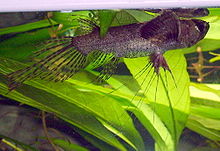
Protomelas taeniolatus is a Haplochromine cichlid endemic to Lake Malawi in Eastern Africa. The fish is popular in the aquarium hobby due to the bright rainbow-like colors of adult males and its relatively peaceful temperament. Juvenile and female P. taeniolatus, like many Haplochromines, do not display bright coloration.

Polypterus senegalus, the Senegal bichir, gray bichir or Cuvier's bichir, and sometimes called the "dinosaur eel", "dinosaur bichir", or "dragon fish" is in the pet trade due to its lungfish-like appearance, which was described as more primitive and prehistoric than other modern fishes. It is a prototypical species of fish in the genus Polypterus, meaning most of its features are held across the genus. It is commonly kept in captivity by hobbyists. They are native from Africa where they are the most widespread species of the genus.

The fork tailed paradisefish, or paradise gourami is a species of gourami found in most types of fresh water in East Asia, ranging from the Korean Peninsula to northern Vietnam. This species can reach a standard length of 6.7 cm, though most are only about 5.5 cm . Paradise gouramis were one of the first ornamental fish available to western aquarium keepers, having been imported 1869 to France by the French aquarium fish importer Pierre Carbonnier in Paris. The paradise fish is one of the more aggressive members of its family. It is more aggressive than the three spot gourami, yet less pugnacious in nature than the less commonly kept combtail.
Community aquaria are tanks that are designed to contain more than one species of fish. Most commonly they include a variety of species that do not normally occur together in nature, for example angelfish from Brazil, swordtails from Mexico, and gouramis from South East Asia. The aim of such communities is to bring together fish that are compatible in temperament and water requirements, while using their different colours and behaviors to add interest and entertainment value.

Fishkeeping is a popular hobby, practiced by aquarists, concerned with keeping fish in a home aquarium or garden pond. There is also a piscicultural fishkeeping industry, serving as a branch of agriculture.
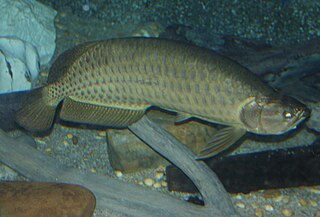
The southern saratoga, also known as the spotted bonytongue, spotted saratoga, or simply saratoga, is a freshwater bony fish native to Australia. It belongs to the subfamily Osteoglossinae, or arowanas, a primitive group of teleosts. Like all arowanas, it is a carnivorous mouthbrooder. Along with the gulf saratoga, the saratoga is also known as the Australian arowana and barramundi, although the latter name is nowadays reserved in Australia for the unrelated Lates calcarifer.

The royal gramma, also known as the fairy basslet, is a species of fish in the family Grammatidae native to reef environments of the tropical western Atlantic Ocean. They are commonly kept in aquariums.
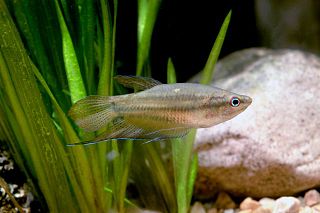
The croaking gourami is a species of small freshwater labyrinth fish of the gourami family. They are native to still waters in Southeast Asia and are distributed worldwide via the aquarium trade. Croaking gouramis are capable of producing a "croaking" noise using their pectoral fins.
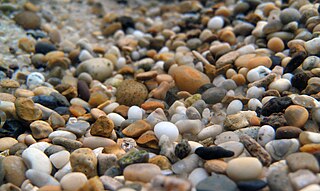
The substrate of an aquarium refers to the material used on the tank bottom. It can affect water chemistry, filtration, and the well-being of the aquarium's inhabitants, and is also an important part of the aquarium's aesthetic appeal. The appropriate substrate depends on the type of aquarium; the most important parameter is whether the aquarium contains fresh water or saltwater.

The pygmy gourami, also known as the sparkling gourami, is a freshwater species of gourami native to Southeast Asia.
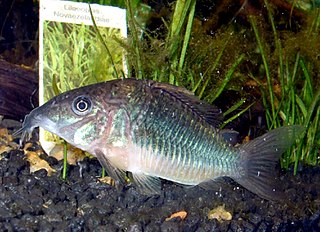
The emerald catfish is a tropical freshwater fish belonging to the Corydoradinae sub-family of the family Callichthyidae native to the Amazon Basin in South America. It has traditionally been known as Brochis splendens. The fish has appeared on a stamp in Brazil.
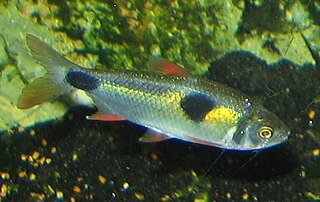
The bucktooth tetra is the only member of the genus Exodon and is a freshwater fish of the characin family of order Characiformes. It is native to the Amazon Basin and Guyana. Though first described in 1845, it was not imported and distributed by the aquarium trade until 1932.
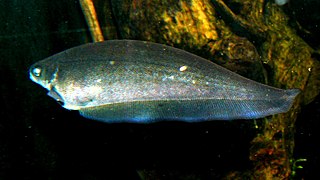
The African brown knifefish, is the only species in the genus Xenomystus of the family Notopteridae. This fish is found in the Chad, Nile, Congo, Ogowe and Niger basins, as well as coastal river basins in Sierra Leone, Liberia, Togo, Benin and Cameroon.

Farlowella acus is the type species of the armored catfish genus Farlowella. Members of this genus are commonly known as twig catfish or whiptail catfish. The specific name of the species, acus, means “pointed” or a “needle” or “spine”.
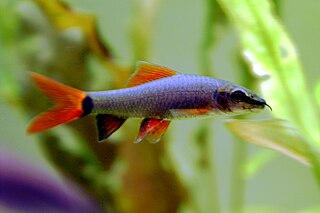
The rainbow shark is a species of Southeast Asian freshwater fish from the family Cyprinidae. It is also known as the ruby shark, red-fin shark, red-finned shark, rainbow sharkminnow, green fringelip labeo, whitefin shark and whitetail sharkminnow. It is a popular, semi-aggressive aquarium fish. Unlike true sharks, which belong to the Chondrichthyes lineage, the rainbow shark is an actinopterygiian.

An aquarium is a vivarium of any size having at least one transparent side in which aquatic plants or animals are kept and displayed. Fishkeepers use aquaria to keep fish, invertebrates, amphibians, aquatic reptiles, such as turtles, and aquatic plants. The term aquarium, coined by English naturalist Philip Henry Gosse, combines the Latin root aqua, meaning 'water', with the suffix -arium, meaning 'a place for relating to'.

Pimelodus pictus, also known as the pictus cat or pictus catfish, is a small member of the catfish family Pimelodidae, native to the Amazon and Orinoco river basins and commonly kept as a pet in freshwater aquariums. Pictus catfish are sometimes mislabeled as Angelicus cats in the aquarium trade, but the latter name actually refers to an unrelated African catfish, the mochokid Synodontis angelica.
The true Kuhli loach, occasionally referred to as eel loach, is a small eel-like freshwater fish belonging to the loach family (Cobitidae). They originate from the island of Java in Indonesia. This snake-like creature is very slender and nocturnal.
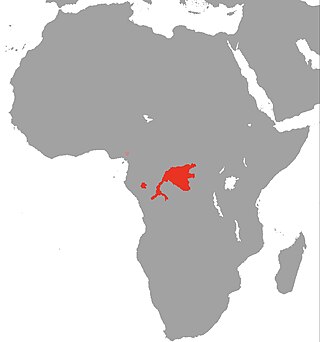
The West African bichir or retropinnis bichir, is a freshwater fish in the family Polypteridae, is found in the central Congo River basin and Ogooué River in Africa. It is a long, slender fish that grows to a maximum length of about 34 cm (13 in).
